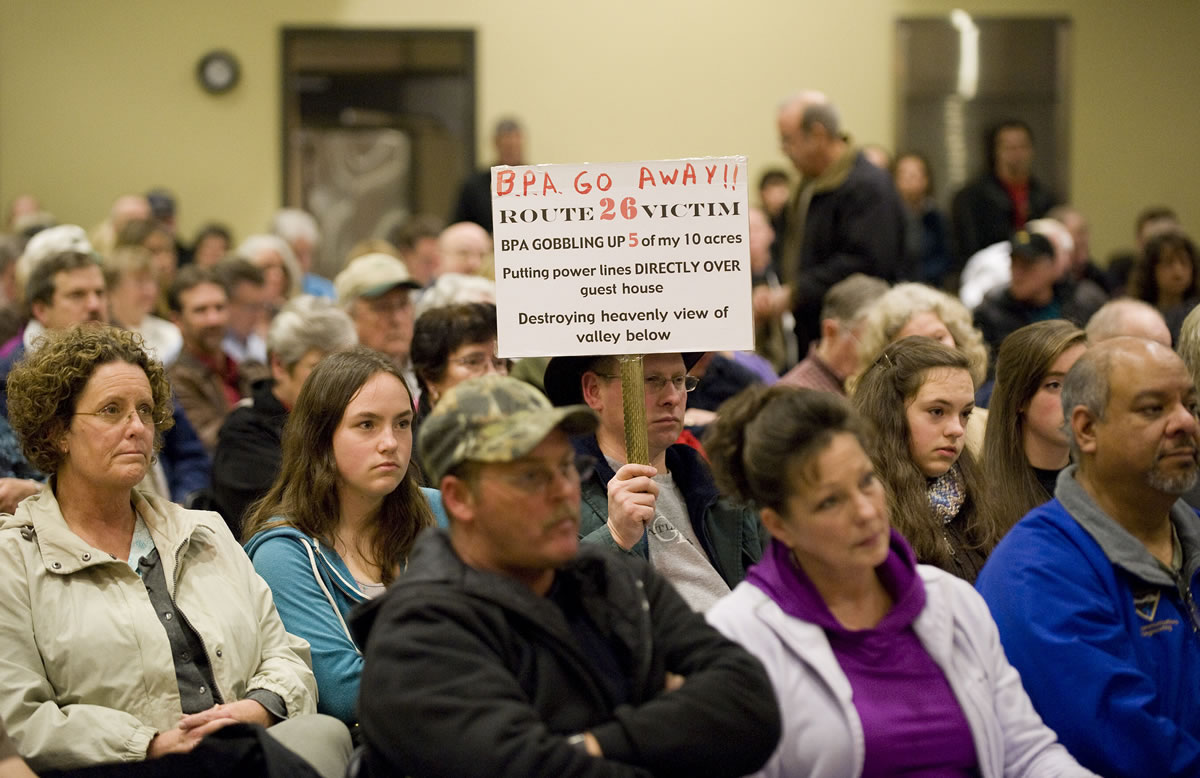See a map of the proposed routes at bpa.gov/go/i-5.
Steve Hambleton and Tom Swire know what it’s like to live in the shadow of a power line. The two neighbors already have a large transmission line cutting through their properties off Northeast Blair Road outside of Washougal.
They’re also left wondering whether a bigger one is on the way — they sit on one of the proposed segments for the Bonneville Power Administration’s planned 500-kilovolt transmission line through Southwest Washington.
“This is such a black cloud hanging over our property,” Swire said.
Hambleton and Swire are among many residents of Clark and Cowlitz counties waiting to see where the proposed line lands. But they’re not the only ones potentially affected by the outcome. Citizen activists have recently crafted a study attempting to quantify the property tax burden borne by those who don’t live on a proposed route, but may pay extra no matter which option is chosen. The result? As much as a combined $12 million annually in both counties.
“This affects everybody,” said Terry Constance, a citizen advocate who helped put together the study.
When BPA acquires new property for the project — thus taking that land off the tax rolls — other landowners pick up the difference to make up for lost revenue. Individually, exactly how much depends on the various taxing districts a person lives in, according to Clark County Assessor Peter Van Nortwick.
The total “tax shift” paid by Clark and Cowlitz residents could be $12 million if BPA chooses its proposed west route, which would send part of the transmission line into the Vancouver urban area, according to the study. Three other BPA-proposed routes range from $4 million to $8 million, according to the study.
Property, health concerns
The numbers factor in projected property acquisitions only, Constance said. They do not include right-of-way acquisitions or purchased easements, which don’t take land off the tax rolls, he said.
BPA first floated the transmission line project in 2009 as a way to ease a strained Northwest power grid. The federal power marketing agency laid out four main routes to carry the 500-kilovolt line — held up by 150-foot utility towers — between Castle Rock and Troutdale, Ore., crossing the Columbia River at Camas.
The idea has drawn strong push-back from residents with property and health concerns. The citizens who drafted the “tax shift” study are among those who have advocated for pushing the line farther north and east than any of BPA’s options.
BPA is expected to announce its preferred route by the end of this year, when it releases a draft environmental impact statement for the $317 million to $407 million project.
The cost of property, easements and right of way is rolled into those numbers, said BPA spokesman Doug Johnson. But the agency doesn’t plan to identify route-specific property costs in its analysis, he said. It is, however, mindful of worries from residents watching the process closely.
“We do understand that there will be certain impacts, and we’re studying them,” Johnson said.
Waiting, wondering
For Hambleton and Swire, the transmission line adds uncertainty to an already difficult reality: In their most recent assessments from Clark County, both saw their property values drop more than 25 percent. In one year.
Hambleton wondered aloud if the specter of a new transmission line on his land pushed the value down. Local Realtors said an unbuilt project can have an effect, but it’s difficult to pin the declining numbers on any one factor. Most local values are already battered by a still-struggling real estate market.
That doesn’t make the possibility of further decline any easier to swallow.
“You’re already down,” Swire said. “Why kick us again?”
Several factors play into assessed values each year, said Van Nortwick, the county assessor. Nearby sales play a role, he said, along with periodic visits to various parts of the county.
Van Nortwick said he feels for landowners on one of the proposed BPA routes. He counts himself among them — Van Nortwick lives in the Salmon Creek area, where one of the proposed segments may land. It’s a tough situation for people left in limbo by the project, he said.
“If you don’t know, it’s almost worse,” Van Nortwick said. “Then you don’t know when to plan.”
BPA is analyzing property value impacts as part of its analysis, Johnson said.
The environmental impact statement with more detailed information about the project is due out by “late fall,” according to BPA.
Eric Florip: 360-735-4541; http://twitter.com/col_enviro; eric.florip@columbian.com.




